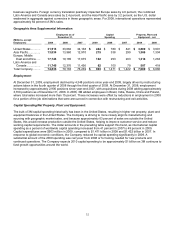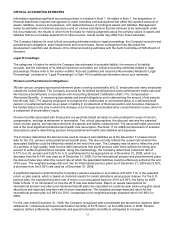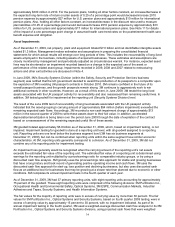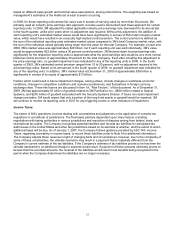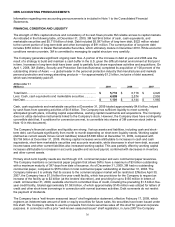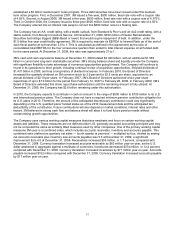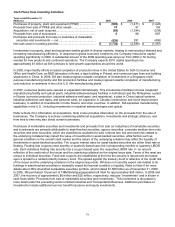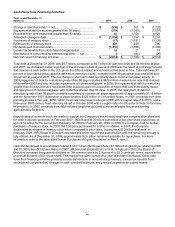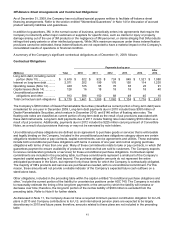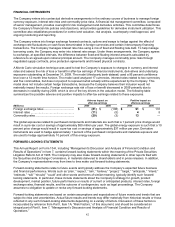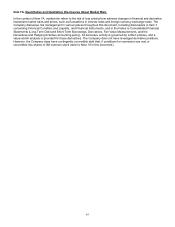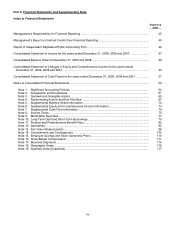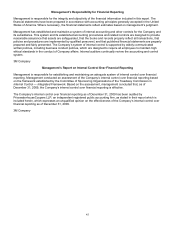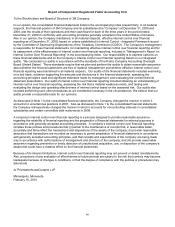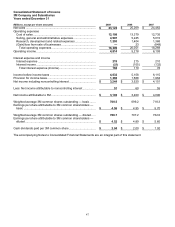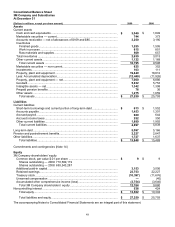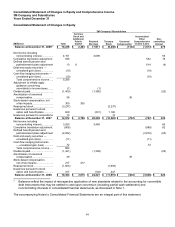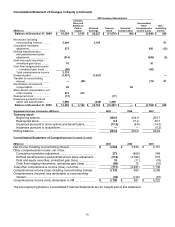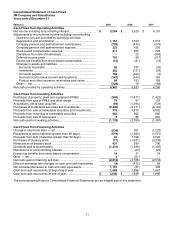3M 2009 Annual Report Download - page 48
Download and view the complete annual report
Please find page 48 of the 2009 3M annual report below. You can navigate through the pages in the report by either clicking on the pages listed below, or by using the keyword search tool below to find specific information within the annual report.
42
FINANCIAL INSTRUMENTS
The Company enters into contractual derivative arrangements in the ordinary course of business to manage foreign
currency exposure, interest rate risks and commodity price risks. A financial risk management committee, composed
of senior management, provides oversight for risk management and derivative activities. This committee determines
the Company’s financial risk policies and objectives, and provides guidelines for derivative instrument utilization. This
committee also establishes procedures for control and valuation, risk analysis, counterparty credit approval, and
ongoing monitoring and reporting.
The Company enters into foreign exchange forward contracts, options and swaps to hedge against the effect of
exchange rate fluctuations on cash flows denominated in foreign currencies and certain intercompany financing
transactions. The Company manages interest rate risks using a mix of fixed and floating rate debt. To help manage
borrowing costs, the Company may enter into interest rate swaps. Under these arrangements, the Company agrees
to exchange, at specified intervals, the difference between fixed and floating interest amounts calculated by
reference to an agreed-upon notional principal amount. The Company manages commodity price risks through
negotiated supply contracts, price protection agreements and forward physical contracts.
A Monte Carlo simulation technique was used to test the Company’s exposure to changes in currency and interest
rates and assess the risk of loss or benefit in after-tax earnings of financial instruments, derivatives and underlying
exposures outstanding at December 31, 2009. The model (third-party bank dataset) used a 95 percent confidence
level over a 12-month time horizon. The model used analyzed 17 currencies, interest rates related to two currencies,
and five commodities, but does not purport to represent what actually will be experienced by the Company. This
model does not include certain hedge transactions, because the Company believes their inclusion would not
materially impact the results. Foreign exchange rate risk of loss or benefit decreased in 2009 primarily due to
decreases in volatility during 2009, which is one of the key drivers in the valuation model. The following table
summarizes the possible adverse and positive impacts to after-tax earnings related to these exposures.
Adverse impact on Positive impact on
after-tax earnings after-tax earnings
(Millions) 2009 2008 2009 2008
Foreign exchange rates ...................................... $ (81) $(108) $91
$ 131
Interest rates ....................................................... (11) (5) 4 5
Commodity rates ................................................. (20) (3) 13
—
The global exposures related to purchased components and materials are such that a 1 percent price change would
result in a pre-tax cost or savings of approximately $50 million per year. The global energy exposure is such that a 10
percent price change would result in a pre-tax cost or savings of approximately $37 million per year. Derivative
instruments are used to hedge approximately 1 percent of the purchased components and materials exposure and
are used to hedge approximately 10 percent of this energy exposure.
FORWARD-LOOKING STATEMENTS
This Annual Report on Form 10-K, including “Management’s Discussion and Analysis of Financial Condition and
Results of Operations” in Item 7, contains forward-looking statements within the meaning of the Private Securities
Litigation Reform Act of 1995. The Company may also make forward-looking statements in other reports filed with
the Securities and Exchange Commission, in materials delivered to shareholders and in press releases. In addition,
the Company’s representatives may from time to time make oral forward-looking statements.
Forward-looking statements relate to future events and typically address the Company’s expected future business
and financial performance. Words such as “plan,” “expect,” “aim,” “believe,” “project,” “target,” “anticipate,” “intend,”
“estimate,” “will,” “should,” “could” and other words and terms of similar meaning, typically identify such forward-
looking statements. In particular, these include statements about the Company’s strategy for growth, product
development, market position, future performance or results of current or anticipated products, interest rates, foreign
exchange rates, financial results, and the outcome of contingencies, such as legal proceedings. The Company
assumes no obligation to update or revise any forward-looking statements.
Forward-looking statements are based on certain assumptions and expectations of future events and trends that are
subject to risks and uncertainties. Actual future results and trends may differ materially from historical results or those
reflected in any such forward-looking statements depending on a variety of factors. Discussion of these factors is
incorporated by reference from Part I, Item 1A, “Risk Factors,” of this document, and should be considered an
integral part of Part II, Item 7, “Management’s Discussion and Analysis of Financial Condition and Results of
Operations.”


